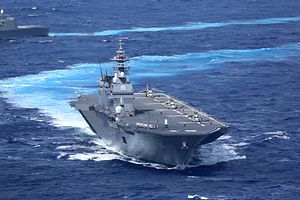Suddenly, navies seem to be getting inordinately excited about the F-35B.
Earlier this week, reports emerged of discussions about the idea of modifying Japan’s Izumo class helicopter carriers to operate the F-35B. Japanese officials half-heartedly denied the report, which would apparently involve fitting a ski-jump and altering the flight deck to resist the high heat of the F-35B’s exhaust. At 24,000 tons, the Izumos are large enough to pose a credible threat if equipped with a group of Joint Strike Fighters, although such a complement would necessarily reduce their effectiveness in other roles.
The report of Japanese interest in upgrading the Izumos was followed hard by reports from South Korea suggesting an interest on the part of Republic of Korea Navy (ROKN) on modifying the Dokdo class amphibious assault ships to carry the F-35B, as well. At 14,000 tons, the Dokdos are considerably smaller than the Izumos, and consequently not nearly as capable. Dokdo, first of the class, would have to undergo significant reconstruction in order to operate the F-35B, and even the second ship of the class (currently under construction) would require heavy revision. That said, the 15,000 ton Spanish Principe de Asturius carried 12 AV-8B Harriers in her day. The Dokdos would probably lose any amphibious capabilities in their conversion, however.
The sudden interest in the F-35B may reflect a changing assessment of the threat environment in East Asia, at least in Japan’s case; the South Koreans may just be playing catch up for the sake of prestige. Thus far, neither South Korea nor Japan have ordered the F-35B. If they do, however, we can expect that the Royal Australian Navy will come under pressure to upgrade its Canberra class amphibious assault ships for use of the F-35B, not because Australia anticipates conflict with Japan or South Korea, but rather because the Japanese and South Korean examples would provide ammunition for domestic advocates of acquiring the aircraft.
Moreover, both countries might have some good reason for ordering the F-35B, apart from its ability to land on tiny carriers. China’s armada of ballistic and land attack cruise missiles is only increasing, and many analysts anticipate that the PLA will use these missiles in the opening hours of a conflict to strike airbases and other fixed military installations. The F-35B, at least theoretically, can operate from unimproved areas, thus giving its operators a fighting chance of surviving a first strike. Indeed, the earliest VSTOL (vertical and/or short take-off and landing) concepts came as an answer to concerns over the threat of nuclear strikes against airbases, not so much from a need to populate the flight decks of light aircraft carriers.
It’s also worth wondering whether a competitor to the F-35B will eventually emerge. Few STOVL fighters have made it to the prototype stage, with only the Yak-38, the Harrier, and the F-35B seeing wide service. But if STOVL fighters increasingly meet a defense need, both on land and at sea, then the major aerospace powers may reconsider their development. Indeed, some reports already indicate that Russia has placed a new STOVL fighter in development, although as with any reports about Russian military innovation this should be taken with a grain of salt. Still, if navies around the world become fixated with the idea of equipping their flat-decked aircraft carrying ships with fighters, someone will be there to meet the demand.

































